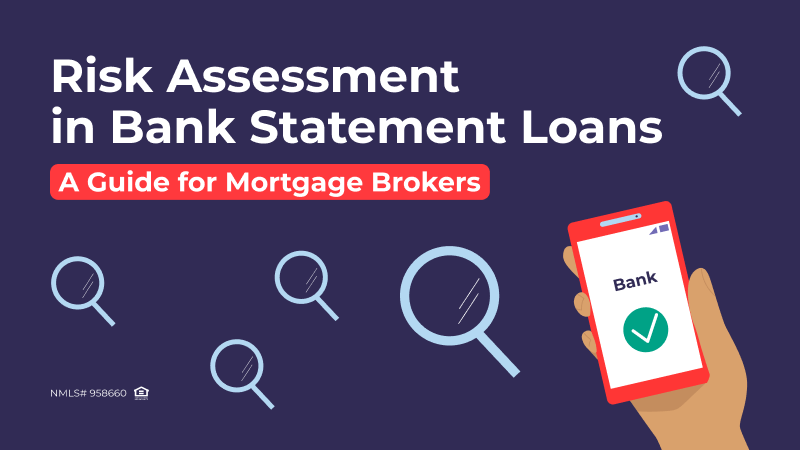
In this third entry of our 4-part series on bank statement loans, we focus on the aspect of risk assessment. Following our exploration of marketing strategies and the latest trends shaping these specialized loan products, this segment focuses on the intricacies of evaluating bank statement, understanding spending habits, and assessing the financial health of self-employed clients. This guide is meticulously designed to empower mortgage brokers with advanced techniques for scrutinizing the unique risk profile of bank statement loans. By equipping brokers with the skills to conduct thorough risk assessments, we aim to enhance their proficiency in advising clients and navigating the bank statement loan process with greater confidence and success.
Bank statement loans serve as a vital solution for self-employed individuals and entrepreneurs who might not meet the traditional income verification requirements for mortgage loans. However, these loans come with their unique set of challenges, particularly in assessing the risk they pose. Mortgage brokers navigating the bank statement loan landscape must understand how to thoroughly evaluate bank statement, interpret spending habits, and gauge the overall financial health of their clients. This guide explores the intricacies of risk assessment for bank statement loans, equipping brokers with the knowledge to make informed decisions.
Understanding Bank Statement Loans
Bank statement loans allow borrowers to use their bank statement to verify income instead of the standard W-2s and tax returns. These loans are particularly beneficial for borrowers with significant income fluctuations, multiple income sources, or considerable business deductions that lower taxable income.
Evaluating Bank Statement

Troubles with a scenario for a borrower?
Message our loan expert and get
a response in 30 minutes.
- Consistency in Deposits. Look for consistent income deposits over the period under review (usually 12-24 months). Consistent deposits indicate a stable income, which is a positive sign of the borrower’s ability to repay the loan.
- Seasonality and Fluctuations. Understand the nature of the borrower’s business and account for seasonality or expected fluctuations. A thorough analysis can differentiate between a risky income pattern and a predictable seasonal variation.
- Non-Sufficient Funds (NSF) Notices. Frequent NSF notices can be a red flag, indicating mismanagement of finances or cash flow problems. Assess the context and frequency of these occurrences.
Interpreting Spending Habits
- Monthly Expenditure. Analyze the borrower’s monthly spending habits to ensure they are not living beyond their means. High monthly expenditures relative to income could impact their ability to make mortgage payments.
- Business Expenses. For self-employed individuals, distinguish between personal and business expenses. Understand which expenses are recurring and necessary for the business and which are discretionary.
- Large, Unexplained Transactions. Unusually large transactions or irregular spending patterns need clarification. These could either be red flags or simply one-off expenses that do not impact the borrower’s financial stability.
Assessing Financial Health
- Cash Flow Analysis. Beyond income, assess the borrower’s cash flow – the real measure of their ability to service a loan. Positive cash flow after all expenses is a good indicator of financial health.
- Debt-to-Income Ratio (DTI). Calculate the Debt-to-Income ratio, considering the borrower’s entire debt load. A high DTI ratio might indicate that the borrower is over-leveraged, even if their bank statement show substantial deposits.
- Savings and Reserves. Evaluate the borrower’s savings and reserves. Sufficient reserves to cover mortgage payments for several months provide a buffer that lenders favor.
Utilizing Technological Tools
Looking for a suitable loan program?
Choose among 20+ programs and get
a detailed loan calculation
Embrace technological solutions that automate and streamline the analysis of bank statement and financial documents. These tools can quickly identify patterns, flag anomalies, and calculate financial ratios, saving time and reducing human error.
Conclusion
For mortgage brokers, effectively assessing risk in bank statement loans requires a deep dive into the borrower’s financial life through their bank statement. By evaluating income consistency, interpreting spending habits, and assessing overall financial health, brokers can make informed decisions about a borrower’s loan eligibility. In doing so, brokers not only protect their interests and those of the lender but also support the financial well-being of their clients, ensuring they are not placed in loans they cannot afford. Understanding these intricacies allows mortgage brokers to better serve a segment of the market that traditional lenders might overlook, providing opportunities for homeownership to a broader range of individuals.


